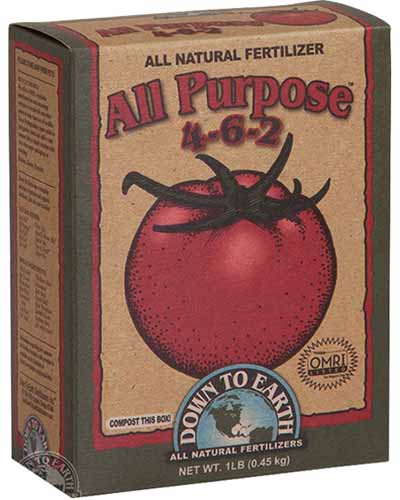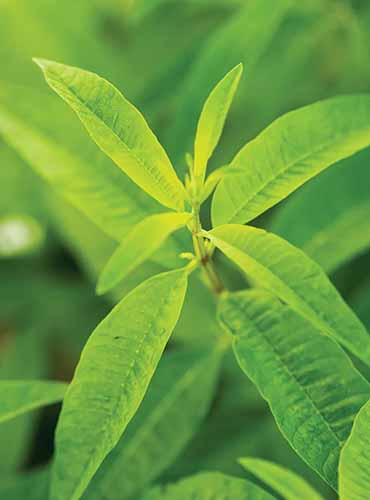How to Grow Lemon Verbena In Your Home Herb Garden
Aloysia triphylla
For years, lemon verbena has been valued for its incredible fragrance and medicinal uses, and some people regularly enjoy it in tea.
But I think this humble woody herb deserves a lot more love than it has gotten. These days, it’s finally gaining the recognition it deserves as an ingredient, not only in desserts but to flavor savory dishes, as well.
As a result, it’s popping up in more and more home herb gardens – not to mention on many restaurant menus and in their gardens out back.


We link to vendors to help you find relevant products. If you buy from one of our links, we may earn a commission.
Baked into bread, whipped into ice cream, baked with chicken, grilled with octopus, or simmered in a curry, this lemony wonder can do it all. Plus, it’s still perfect for all those classic uses in tea, potpourri, soap, and lotions.
It’s hardier than many people realize and rarely succumbs to pests or diseases. Whether you grow it in a container or right in the ground, it’s a versatile shrub that gives and gives, without asking for much in terms of maintenance.
What You’ll Learn
I don’t know about you, but sometimes straight lemon juice is too harsh for use in some of the recipes I’m cooking up.
A little subtlety is in order with certain fish dishes, chicken recipes, and desserts. If you’ve ever encountered that problem, you’re going to love this garden gem, so let’s dig right in.
What Is Lemon Verbena?
Aloysia triphylla, also known as A. citriodora, originated in tropical parts of South America, including Argentina, Chile, Paraguay, Peru, and Uruguay. Today, it’s an herbal favorite across the globe.
You might also see this plant called lemon beebrush in English-speaking regions, and in France, it’s called verveine or verveine citronnelle.
In Morocco, where it’s extremely popular as a tea, it goes by the name Louiza, and as hierba Luisa in Spanish-speaking countries. “Verbena” itself comes from Latin and can be roughly translated as “a leafy branch.”
The opposite leaves form in groups of three, are lanceolate in shape, and medium green. They have a sweet, lemony scent thanks to the citral they contain.
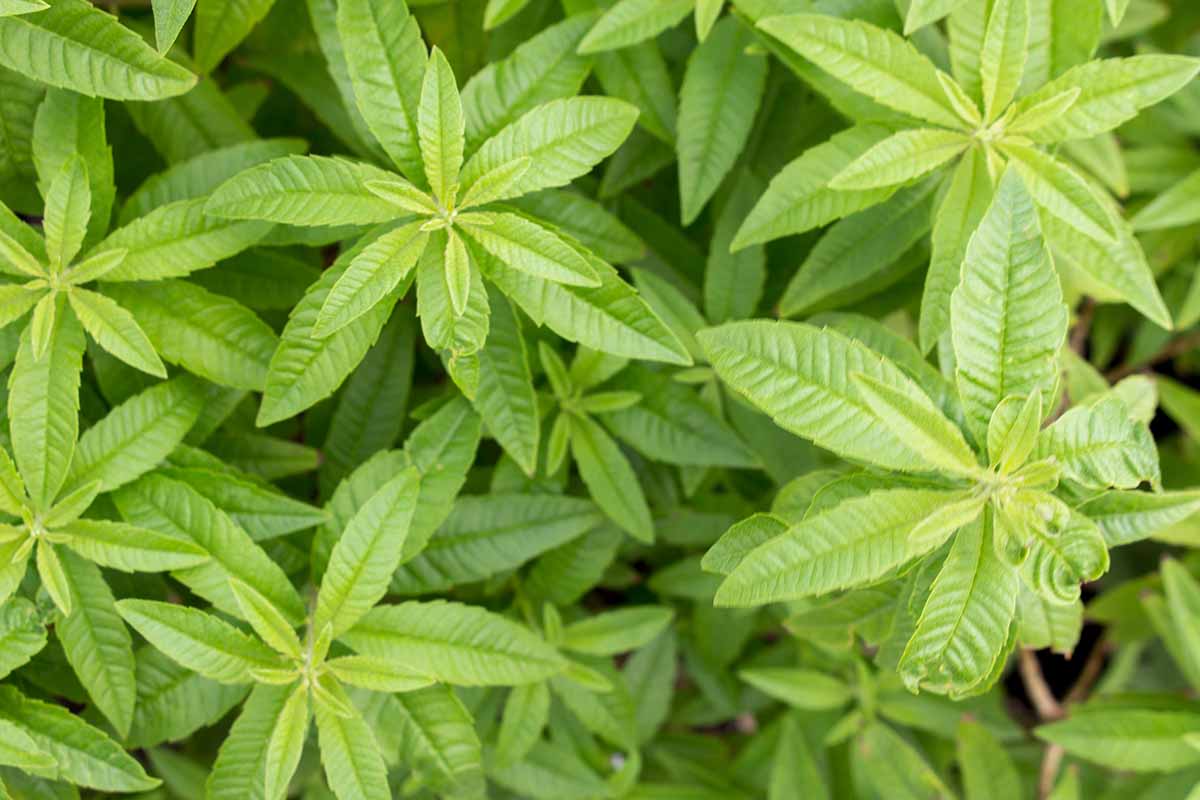

In their native habitat, the plants can grow up to 12 feet tall – or sometimes more! – but in most of North America, they stay much, much smaller.
Potted plants rarely exceed more than four feet tall or so and plants in the ground typically reach about six or seven feet. Grown as annuals, they’ll rarely reach more than a foot or so if you plant a small seedling in the spring.
In mid- to late summer, the plant sends up stalks of purple to white flowers that are highly fragrant, with a hint of citrus and more floral notes than the leaves. The flowers are followed by small brown seed pods.
The essential oil is wildly popular in cleaning products, home fragrances, soaps, lotions, and topical remedies.
However, the essential oil can cause dermatitis in sensitive individuals, and use of the oil is regulated in fragrances in the EU, so it’s not everyone’s cup of tea.


Oh, and yes, it makes fantastic tea that people use as both medicine and for the fantastic flavor!
The woody shrub is a perennial in USDA Hardiness Zones 8 through 10, but you can raise it outside these zones as an annual or in a pot that you can move indoors during the winter.
It can even survive in Zone 7 with some winter protection or if you don’t mind cutting it down to the ground at the end of the season.
This fragrant plant remains evergreen in areas that don’t experience freezing temps, but it will lose its foliage if temperatures drop much below 40°F.
Thanks to that gnarled, woody stem and relatively fast growth, lemon verbena plants are sometimes used to create quick-growing bonsai.
You can also train them into tree forms. Or just let them do their thing and form a bushy shape in a pot or the ground.
Cultivation and History
Lemon verbena has been eaten and used topically in South America for centuries, but Europeans only caught on to the marvelous shrub in the 1700s.
At that point, it gained popularity across western Europe after Spanish invaders brought plants from South America back home with them.
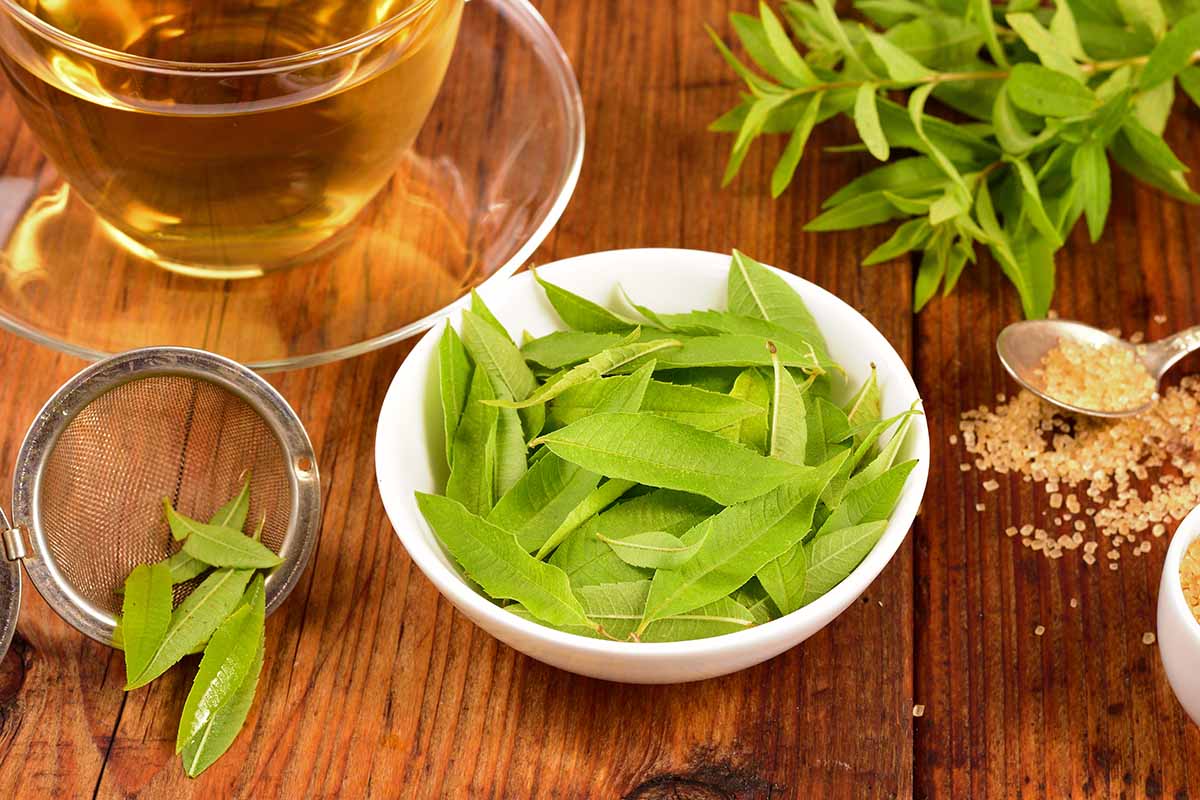

The name Aloysia is derived from Queen Maria Luisa Teresa de Parma (1751-1819), whose husband ruled over Spain when the plant was brought over. The second part of the botanical name, triphylla, is a reference to the three leaves.
By the 1800s, it had reached the shores of North America, and later that century, the Victorians became wild about lemon beebrushes. They used the leaves in potpourri and stuffed them into handkerchiefs as a personal fragrance.
More recently, it has become a staple in many home herb gardens and regularly appears on fine dining menus, and it’s a classic choice for tea.
Propagation
Lemon beebrush is a quick-growing, flowering woody shrub and can be propagated in the same ways as most of these types of plants. Namely, you can grow them from seed, root cuttings, or buy yourself a seedling.
It is technically possible to divide a plant if you have multiple stems coming out of the ground, but I wouldn’t recommend it. The chances of killing both parent and division are pretty high. Stick to taking cuttings instead.
From Seed
You can absolutely start new plants from the little seeds that form in the late summer.
Rather than snipping off the flowers, just let the blossoms turn to seed pods and mature fully. Once the pods are brown and crispy, you can pluck them off the plant and let them dry further for a week or so.
Once they’re fully dry, pop the pods open and sprinkle the seeds into a bowl.
Now they’re ready for planting or you can put them in an envelope to store for next year. Store seeds in a cool, dark place.
To plant, prep a small pot or seed tray with a seed-starting medium.
Any pot three inches in diameter or larger will do nicely, but I’d recommend you go the seed tray route, and here’s why: lemon verbena seeds, especially those harvested from homegrown plants, have notoriously low germination rates.
If you see one out of four sprout, you’re doing well. So it’s a bit of a waste of space if you try to plant an individual seed in each pot.
You could also plant multiple seeds in each pot, but then if you have four seeds germinate in one pot and none in another, you’re in a bit of a pickle. Still, if you have lots of pots lying around and some space to keep them in, feel free.
Sow each seed about a quarter-inch deep, and six inches apart if you’re planting in a tray. Water the medium well.
Place the pots or tray in a location that receives at least six hours of light per day. The seeds themselves don’t need light to germinate, but the seedlings will be greedy for light once they emerge.
Keep the soil moist and cross your fingers or do your favorite good luck ritual while you wait up to four weeks for the seeds to germinate.
Once they do, let them grow until there are at least six leaves each and a good two inches or more of growth. Now you can harden them off.
This part is easy, now that you’ve gotten all the hard work out of the way. Just take your new lemon verbena babies outside and let them bask in the sunlight for an hour, but protect them from wind. Then take them back inside and tuck them back into their usual spot.
Each day for the next week, bring them outside for an hour longer each time until those puppies can chill outside all day long, for a full eight hours of sunbathing. Now you can plant them in their permanent home.
From Cuttings
To begin, find a four-inch container and fill it with seed-starting medium. Cuttings should be taken in the spring before the plant blooms.
Take a clean pair of clippers and snip a six-inch branch that has at least two leaf nodes. You want a branch that is young and supple, not old and woody.
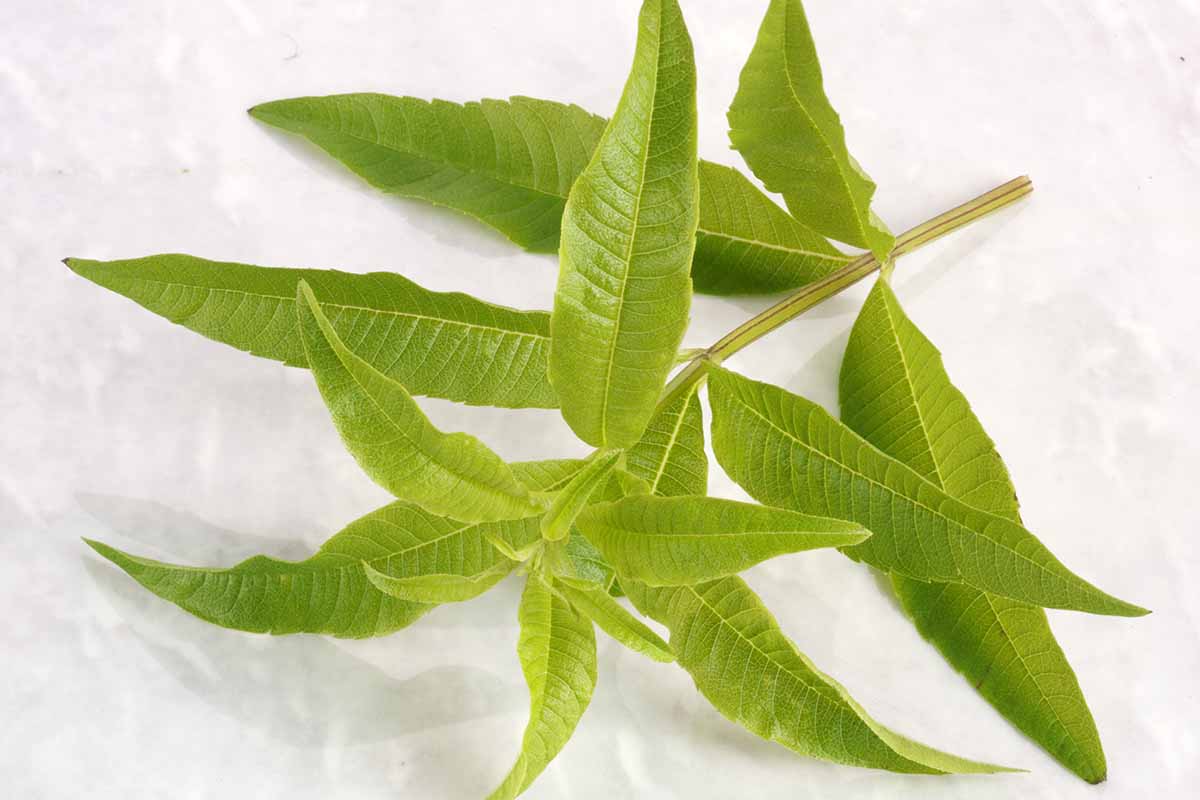

Remove any leaves from the bottom half. Cut the base of the stem at about 45 degrees and dip it in a rooting hormone.
Insert the stem an inch deep into the seed-starting medium and insert a taller chopstick or stick about an inch away. Water the medium well so that it is moist but not wet.
Prop a plastic bag over the container. The stick should hold the plastic off of the leaves. Place the cutting somewhere it will receive several hours of direct sunlight.
Every day or two, lift the plastic and poke your finger into the soil. It should feel moist. If it doesn’t, add water and give the plant a spritz with a spray bottle.
If you live in Zone 9 or 10, you can place the cutting outside in the ground as soon as roots have formed. Give the cutting a tug and see if it resists. If it does, it has roots. Harden the plant off for a week and then plant away.
If you’ve never hardened a rooted cutting off before, it’s basically the process of gradually introducing a young plant to the big outdoor world, the same as you would do with seedlings.
Place the cutting in a protected area for an hour and then bring it back indoors. The next day, add an hour before returning it to your home. Add an hour a day until a week has passed, and you’re ready to transplant.
From Seedlings/Transplanting
If you opt to buy a seedling at the nursery or a grocery store, your job is pretty darn easy.
First things first, prep the soil or container where you’re going to plant your new treasure. That means filling a gallon-size pot, or something larger, with potting soil or working in plenty of well-rotted compost if you have sandy or clay soil.
Next, dig a hole as deep and twice as wide as the container the herb came in. Remove the plant from the container and gently tease the roots apart to loosen them up a bit. Place it in the hole you dug and firm around it with soil or potting medium.
Water well and be extra careful to keep the soil moist for the first few weeks after planting.
How to Grow
Lemon verbena is a sun lover. If you want it to be really happy, make sure it receives at least six hours of sun per day, though eight or more is better. It will survive in less sun, but it will be even leggier than normal and it will be more susceptible to disease.
It’s also a fan of soil that’s consistently moist. Again, it will tolerate short periods of drought, but the leaves might turn brown and dry and the plant will suffer if it goes on too long. Ideally, let the soil dry out to an inch deep and then add more water.
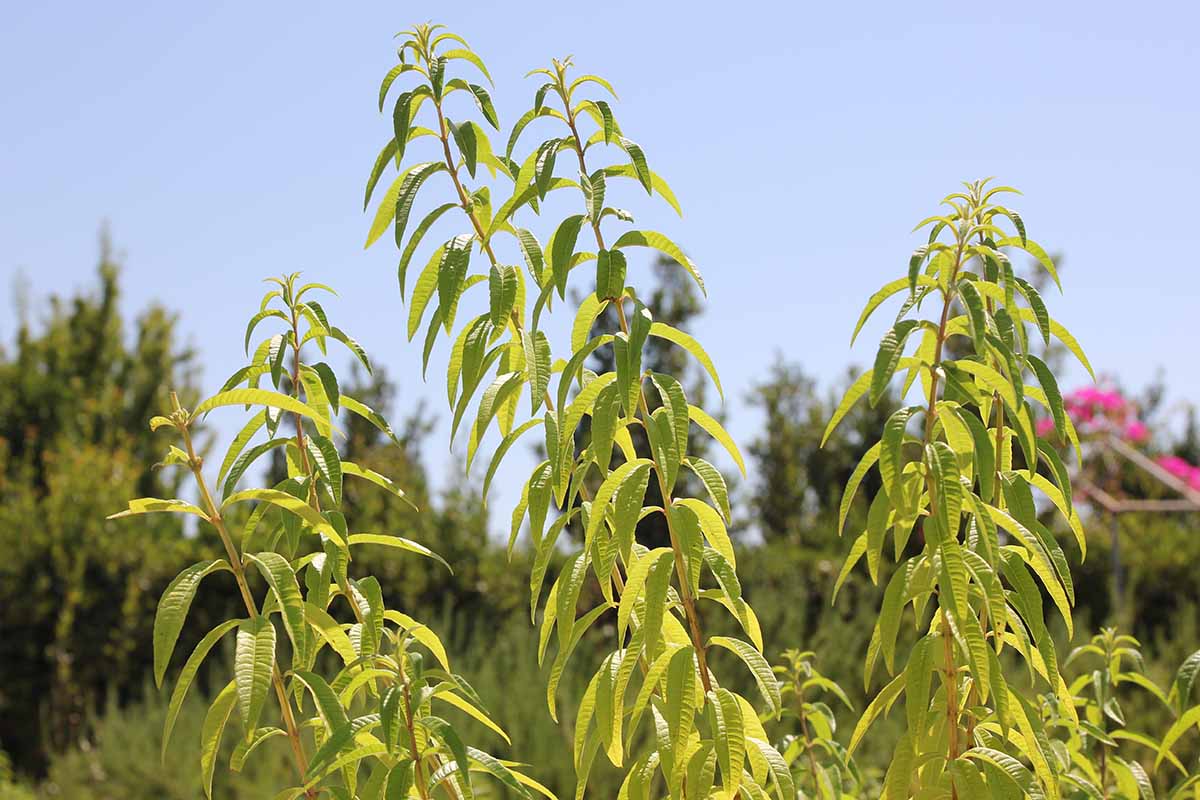

In other words, that means just the top bit should dry out. If you were to stick your finger in the soil, you would feel moisture once your finger is in deep enough to reach your first knuckle.
The plant will be fine if the top two inches dry out, but anything more and you’re asking for trouble.
If your soil isn’t well-draining and loamy already, you have two options. The first is to work in plenty of well-rotted compost or manure until it is nice and loamy at least two feet deep and two feet wide.
Otherwise, you can plant in a container or raised bed.
Many herbs out there don’t demand much in terms of feeding, but not our friend lemon beebrush. It’s hungry all the time, like a Labrador retriever that hasn’t eaten anything in 15 minutes.
I might be exaggerating a bit, but it does actually need feeding much more often than most other herbs.
In the spring, apply an all-purpose fertilizer as the leaves are beginning to bud. Do it again in the summer when the blossoms have formed or about eight weeks after the last time you fertilized, but this time, apply half of the recommended amount.
I love good, old reliable Down to Earth All Purpose Fertilizer. It’s certified for organic growing and comes in a compostable box, and it never fails to make my plants grow big and strong.
Down to Earth All Purpose Fertilizer
Arbico Organics carries it in one-, five-, and 15-pound containers.
This herb grows well with all of the classic herbs: sage, chives, mint (and mint relatives like lemon balm), oregano, and thyme.
Container Growing
Lemon verbena grows really well in containers. Since it’s naturally a bit leggy, I like to combine it with friends that have similar growing requirements.
Right now, mine are happy growing next to some lavender and horehound in one pot, and tarragon and chocolate mint in another. Anything that likes fairly moist soil and full sun is fair game.
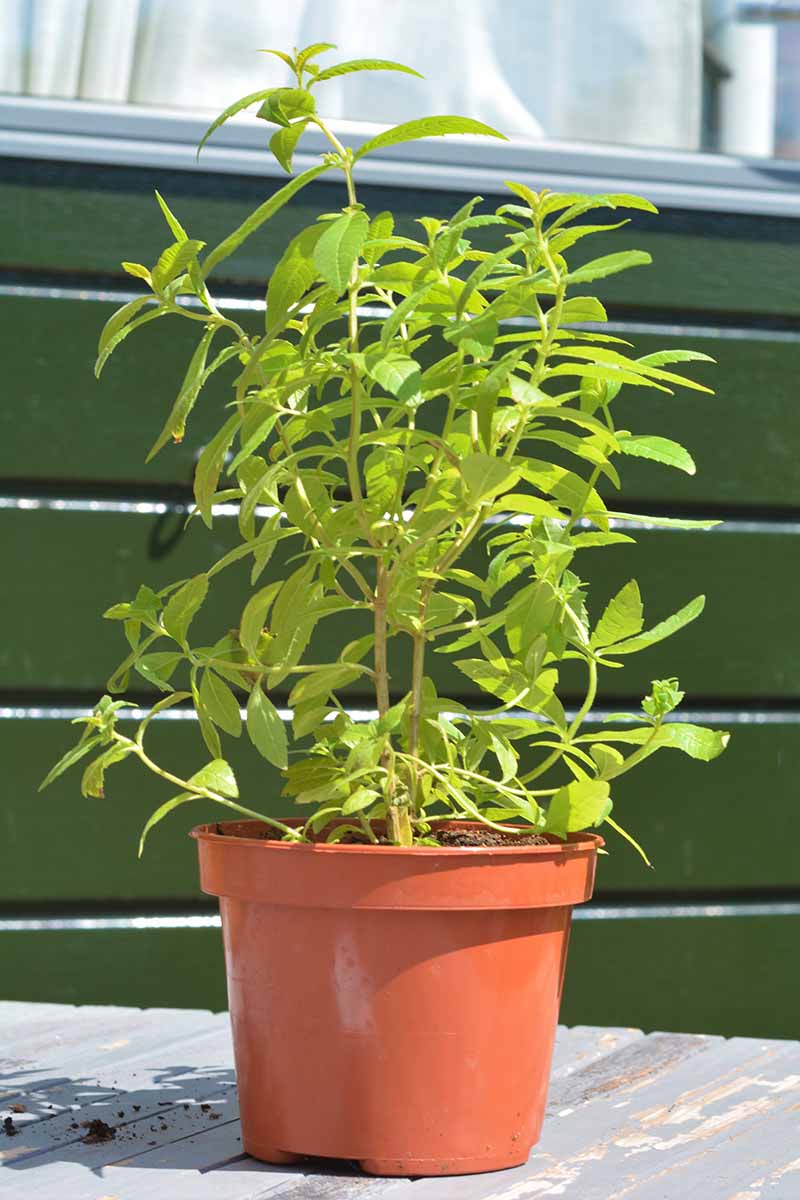

By the way, don’t stress if your potted plant doesn’t bloom. You didn’t fail as a lemon beebrush parent. It’s common and nothing to worry about.
This plant is a heavy feeder, and you’ll need to be extra diligent about fertilizing if you’re growing it in a container.
If you keep yours outside and you have a prolonged freeze coming, protect the plant or bring it indoors.
Having said that, these are hardier than you might realize, given that the leaves die off at the merest suggestion of a freeze. But the wood and roots can survive temperatures below freezing.
If you forget to pay attention to the forecast or are out of town when temps take a nosedive, your plant will probably survive – provided it doesn’t dip too far below freezing for too long. I wouldn’t tempt fate, though.
Wrap the plant in blankets or put it inside if there is a freeze on the horizon.
If your plant does experience a hard freeze and the leaves die off, wait until the spring to take action.
At that point, gently bend the limbs to see if they feel supple or dry. If they break, that branch is dead and you should trim it off. But any branch that remains supple should be left in place. It will likely sprout new leaves.
Be patient – your lemon verbena won’t resprout until it’s certain there aren’t any chilly days on the horizon.
One year, mine only started producing new growth in mid-May, but we had a long, cold spring. I wasn’t sure if it would make it since the plant was exposed to temperatures in the mid-teens for several days in a row during the winter.
It was even covered in ice and snow for weeks at a time, and I was sure it was toast!
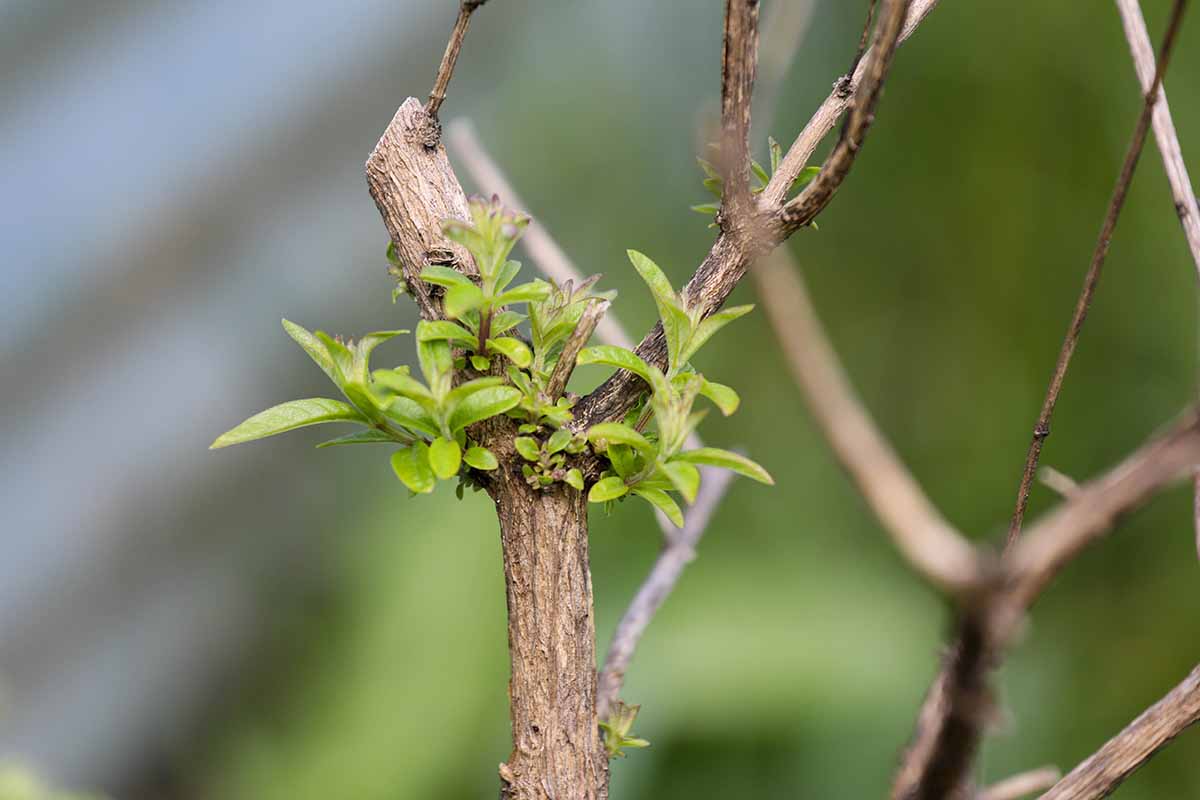

It took some time, but it made a full recovery, though a few branches died and had to be trimmed off.
Alternately, you can cut your plant back to the ground in the late fall and it will resprout new growth from the roots in the spring. This is a good option if you know you’ll experience several freezes through the winter.
Growing Tips
- Plant in full sun.
- Allow the top inch of soil to dry out between watering.
- Fertilize in the spring and summer.
Pruning and Maintenance
Repeat after me: pinch, pinch, pinch.
Lemon verbena does best if you pinch the heck out of the young stems. These plants tend to be quite sparse and leggy as they mature, but you can offset this a little by pinching regularly to encourage bushiness.
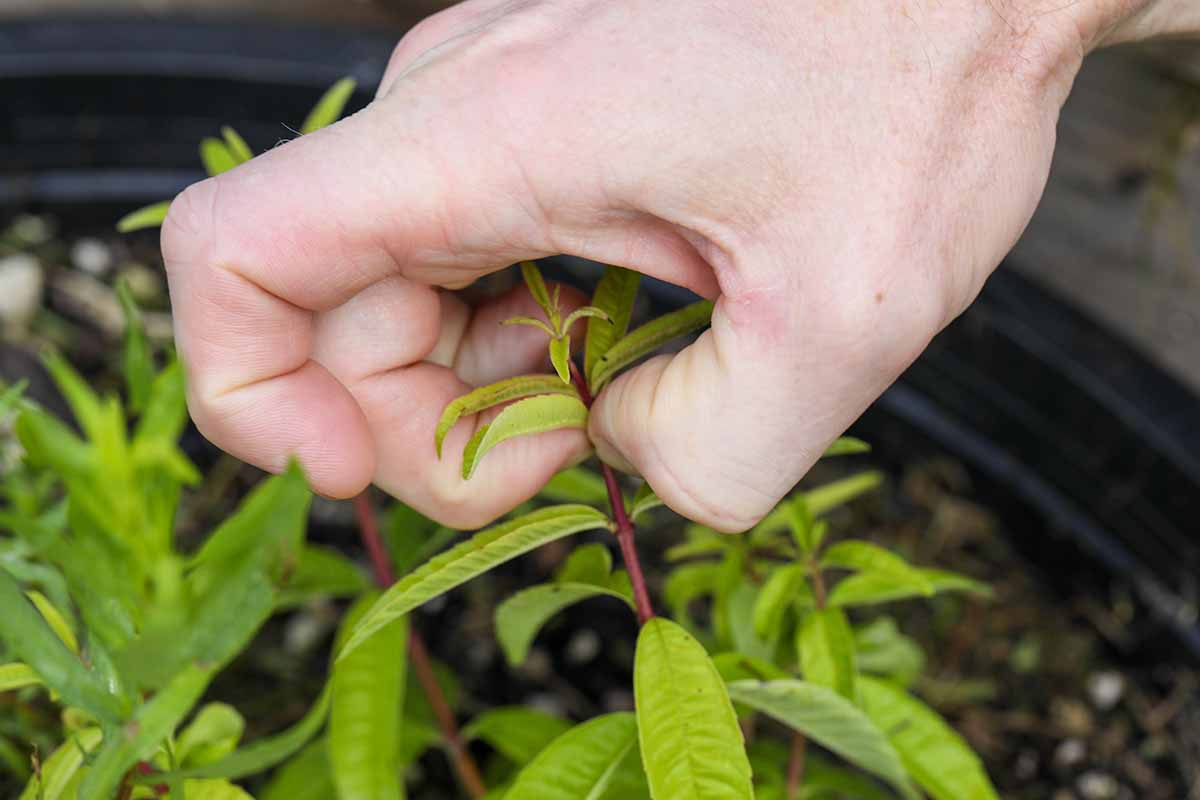

If you’re growing yours as an annual, there’s no further maintenance necessary. However, if you’re growing yours as a perennial, there’s a bit more work ahead.
You want to prune the plant to shape it and remove any dead branches in the spring as the buds are forming.
If you’re growing in Zone 7, you’ll likely need to remove dead branches each year, while people in warmer regions might only see them now and then.
When you do this, wait until summer to start removing stuff. You won’t know for sure which ones are dead and which are just taking their sweet time to bud until late May. At that point, remove anything that doesn’t have new growth on it.
You should also feel free to prune the plant back by a third each spring in all zones as the new growth is forming.
This helps maintain a compact growth habit. Anywhere you make a cut, the plant will send out multiple new branches, so think of this grooming as an investment in your future harvests.
Where to Buy
When you head out to pick up a seedling for your garden, you don’t have to worry about which cultivar or hybrid is right for your particular area, or if you’re missing out on some interesting variety that isn’t available in your neck of the woods.
That’s because there’s only one cultivated variety available for sale, the main species plant. Sure makes things easy, doesn’t it?
You can find plants available at Burpee.
Don’t confuse this plant with lemon balm. They have common names that are confusingly similar and they both have a bold lemon scent, but they’re completely different plants.
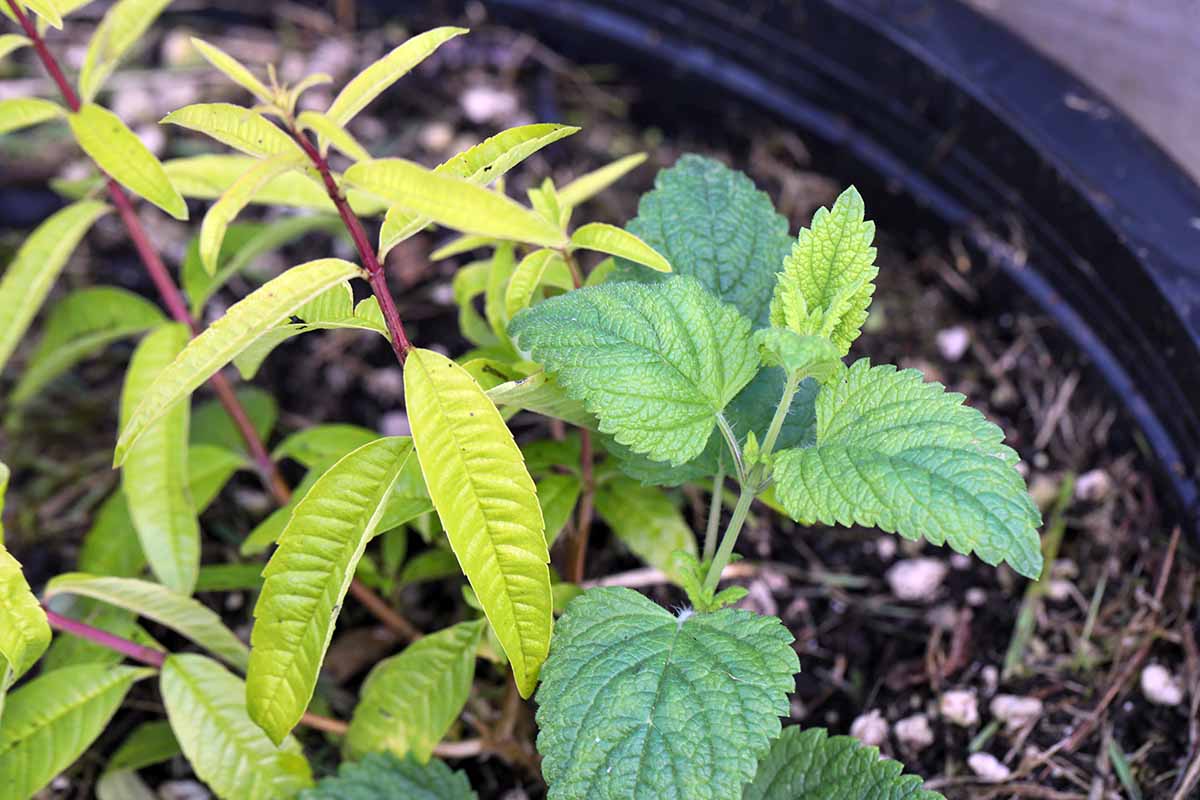

Lemon balm is a mint relative and it looks like it. It’s also somewhat invasive and, in my opinion, has an inferior flavor.
Managing Pests and Disease
While herbivores generally seem to ignore this herb (they don’t know what they’re missing!), it is often visited by several different types of insects and one nasty fungus.
Once a week, you should look at your plant closely. This is a good way to head off any pests or diseases as they’re starting.
Here’s what to know:
Insects
Most of those super common insects that seem to bug all kinds of different floral species will also attack lemon verbena.
Fortunately, most of them are simple to deal with and don’t usually cause too much damage unless you have a really massive infestation.
Aphids
If you look at any list of common pests that feed on a particular herb or veggie, you can pretty much count on aphids being there.
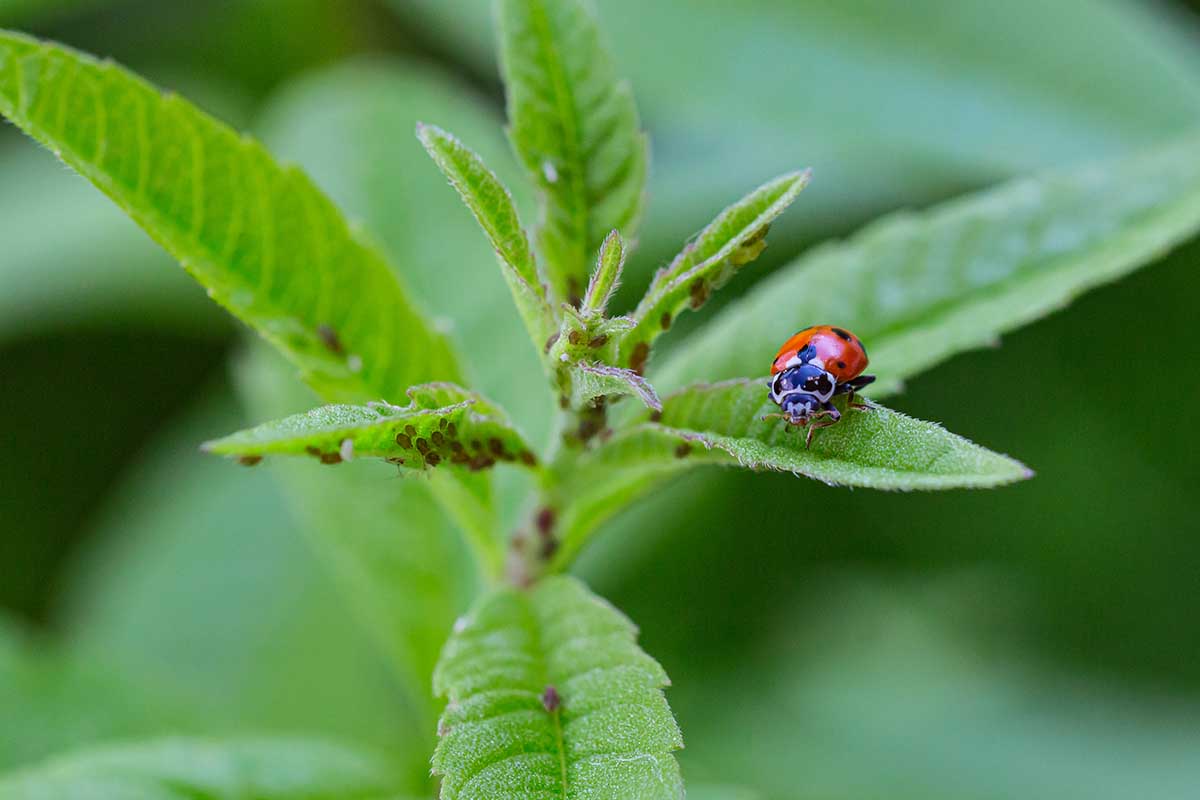

Aphids are small sap-sucking insects in the superfamily Aphidoidea, and a number of different species will feed on lemon verbena. When they attack, the leaves will turn yellow and they might be covered in a sticky substance known as honeydew.
To learn all about identifying and eliminating this common pest, read our guide.
Mealybugs
Like aphids, mealybugs are small sapsuckers and they’re also extremely common. From the family Pseudococcidae, they drain the life out of your plant, turning the leaves yellow, and large enough infestations can even kill it.
To learn how to identify mealybugs and get an infestation under control, check out our guide.
Spider Mites
If you’ve never dealt with spider mites before, consider yourself lucky. These pests are pretty common, both on indoor herbs and those grown outdoors.
Typically, it’s the two-spotted mite (Tetranychus urticae) that you’ll be dealing with, but these tips apply to any mite species. These pests are especially dangerous to stressed plants.
You probably won’t notice the yellowish-brown mites themselves because they’re tiny. We’re talking like a 50th of an inch long.
But once there are enough of them present, you’ll start to notice fine webbing all over the plant. You might also see yellow stippling or spots on the leaves, and the plant might be generally sad and limp-looking.
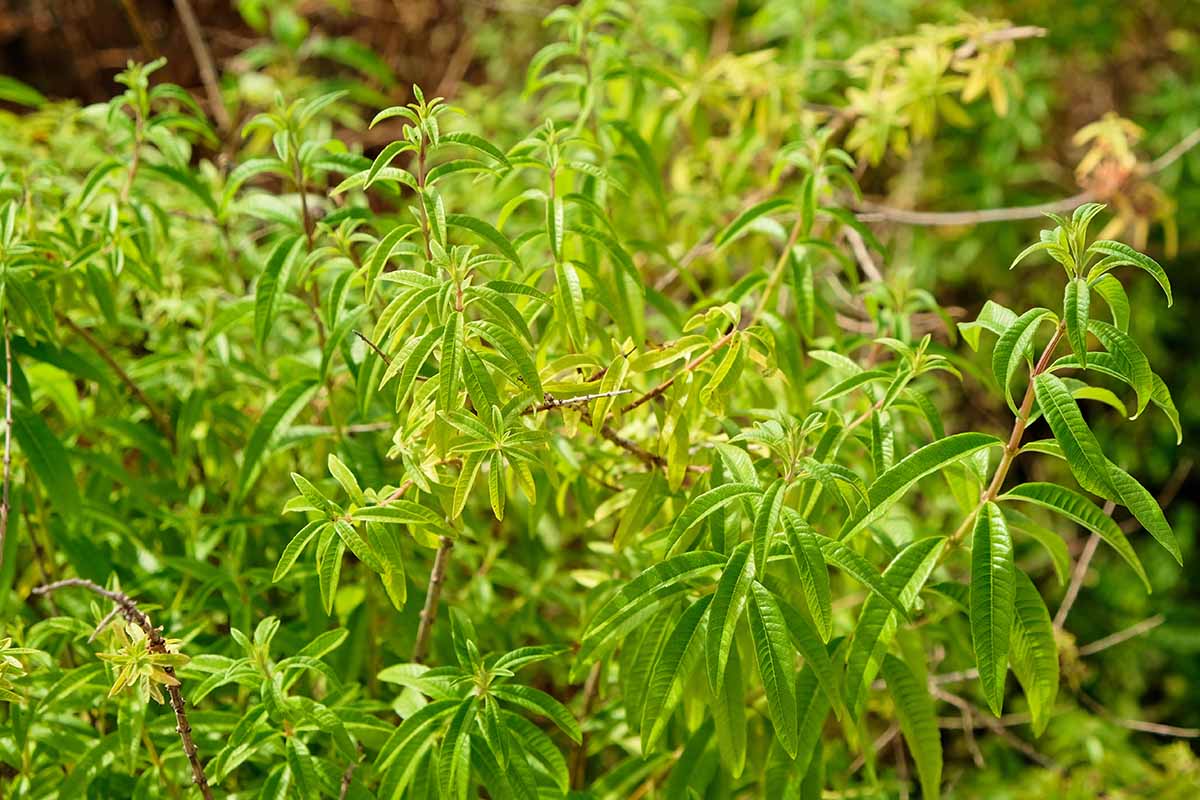

That’s when it’s time to act. Spray the plant with a strong blast of water to knock the little jerks off. Then, buy or encourage ladybugs and predatory mites to hang out in your garden.
I don’t know about you, but I don’t know how the heck to invite the good mites to my garden. Hang up a teeny-tiny help wanted sign?
A healthy ecosystem naturally contains both good and bad mites, but if you want to tip the balance in your favor, throw some money at the problem.
Head to a garden supply store like Arbico Organics and buy yourself 2,000, 4,000, 6,000, or 10,000 Phytoseiulus persimilis mites, which are the gold standard for eliminating spider mites.
With time, your little mite problem should become nonexistent.
Whiteflies
Noticing little white speckles all over your plant’s leaves? Look closer. Those might be whiteflies, tiny insects from the family Aleyrodidae.
If you disturb them, they’ll flutter about in a little puff of white. The damage they leave behind appears in the form of yellow leaves, stunted growth, and necrosis.
Dealing with them is both imperative and fairly simple. Our guide to whiteflies can help.
Disease
There’s really only one disease to watch out for, and it isn’t too scary. In fact, it probably won’t kill your plant (though never say never…) and it’s easily eradicated. The bad news is that it’s also extremely common.
Powdery Mildew
Powdery mildew causes telltale powdery spots to appear on the leaves of your herb. And the various species of fungi in the order Erysiphales that cause this disease love nothing more than a nice long stretch of warm, dry weather.
Our guide has helpful tips on some excellent organic methods to prevent and treat this disease.
Harvesting
Ready to pick?
First, you can simply pull leaves off the plant here and there as you need them. Try to pick from different areas on the plant so you don’t end up with some funny bald patches.
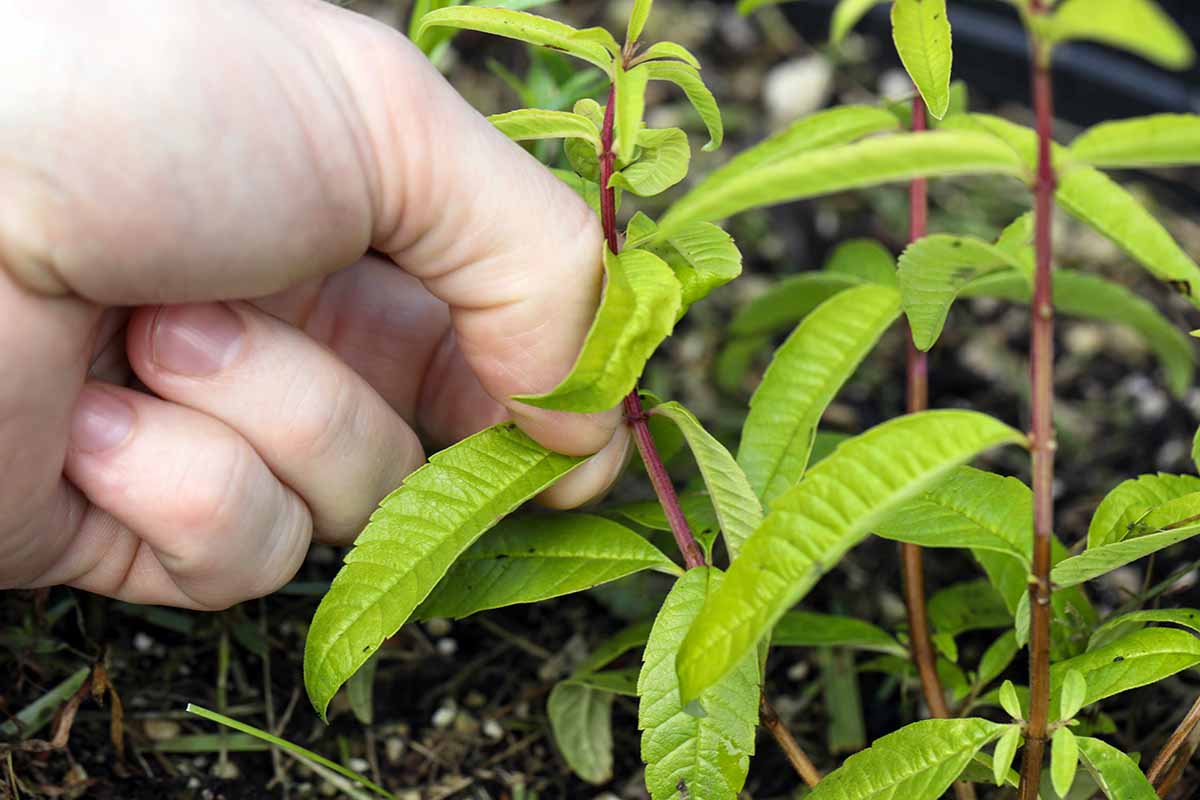

Or you can cut stems if you need a larger harvest. Just don’t take more than half of the plant at a time. Cut off the flower heads once the blooms are fully open and gently pull them off the branch.
The leaves are best just before the plant flowers, and you should pick them in the morning for a moisture-rich harvest with the best flavor.
Preserving
The easiest way to preserve the leaves is to simply dry them. They retain their fragrance and flavor, though slightly altered (and not in a bad way), for a long while.
We have a guide to walk you through the process of drying the leaves for later use. If you want to make tea, this is the way to go.
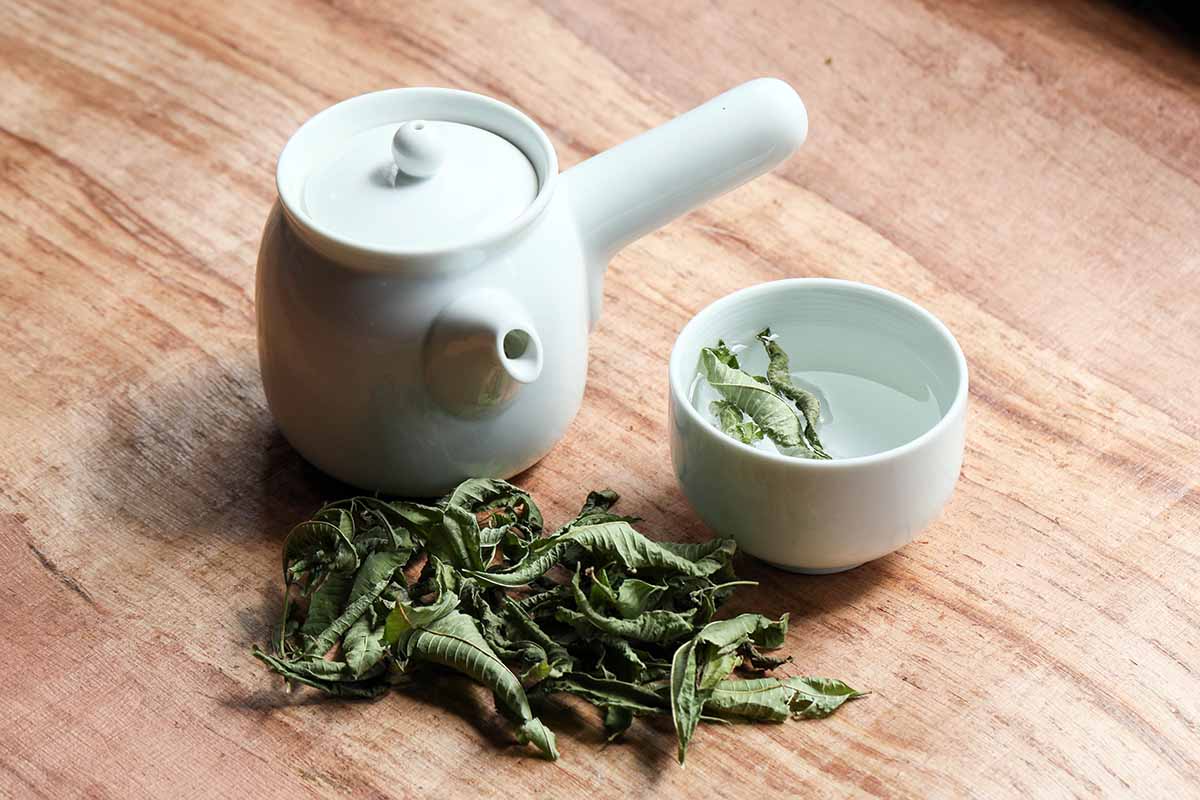

You can also freeze the leaves. Wash them first and then put a few leaves into each section of an ice cube tray. Pour cold water over them and then put the tray in the freezer.
Recipes and Cooking Ideas
Lemon verbena is perhaps most famous as a tea or addition to desserts, but it can be equally as delicious on meat or fish.
Of course, there’s a reason people love the leaves and blossoms on ice cream, sorbets, and cakes. The flowers have a perfumed, lemony flavor that matches really well with sugary treats. And if you haven’t added the leaves to fruit syrups, you haven’t lived.
The leaves, dry or fresh, are also perfect as a substitute for lemon juice in a cocktail.
Speaking of lemon substitute, that’s how you can use the leaves in savory dishes, as well. This works particularly well with mild fish or chicken, and in dishes like curry, soups, stir-fries, and pasta.


Grind two parts fresh lemon verbena leaves with one part sugar in a food processor to extract the flavorful oils and you have yourself a lemony sugar to use in all kinds of desserts and drinks.
You could also try this with salt instead, for savory applications like making a spice rub for fish or poultry.
If you decide to use it to flavor a cooked dish, add the leaves at the end of cooking. The oils break down quickly and start to lose a lot of flavor when exposed to high heat.
While the leaves are marvelous additions to food, don’t use the essential oils internally. Keep those for topical uses.
Speaking of which, some people experience sensitivity to the oils, so test a little on your skin before you go slathering yourself in lemon verbena oil or lotions, salves, and other products that contain it.
Quick Reference Growing Guide
| Plant Type: | Woody perennial shrub | Maintenance: | Low |
| Native to: | Tropical South America | Tolerance: | Some drought |
| Hardiness (USDA Zone): | 8-10 | Soil Type: | Loamy, loose |
| Season: | Spring-fall | Soil pH: | 6.0-7.0 |
| Exposure: | Partial to full sun | Soil Drainage: | Well-draining |
| Time to Maturity: | Up to 10 years | Attracts: | Bees, butterflies |
| Spacing: | 6 inches (seeds), 3 feet (plants) | Companion Planting: | Bee Balm, dill, hyssop, lemon balm, mint, tarragon |
| Planting Depth: | 1/4 inch (seeds), same depth as in container (transplants) | Avoid Planting With: | Lettuce and other greens, fuchsia, chard, kale |
| Height: | 12 feet | Order: | Lamiales |
| Spread: | 6 feet | Family: | Verbenaceae |
| Water Needs: | Moderate | Genus: | Aloysia |
| Common Pests and Diseases: | Aphids, mealybugs, spider mites, whiteflies; powdery mildew | Species: | Triphylla (syn. Citrodora |
Make Lemon Verbena a Part of Your Herb Garden
Whether you keep it around for years or just enjoy it for a season, lemon verbena is well worth a try. You might discover that you can’t live without it.
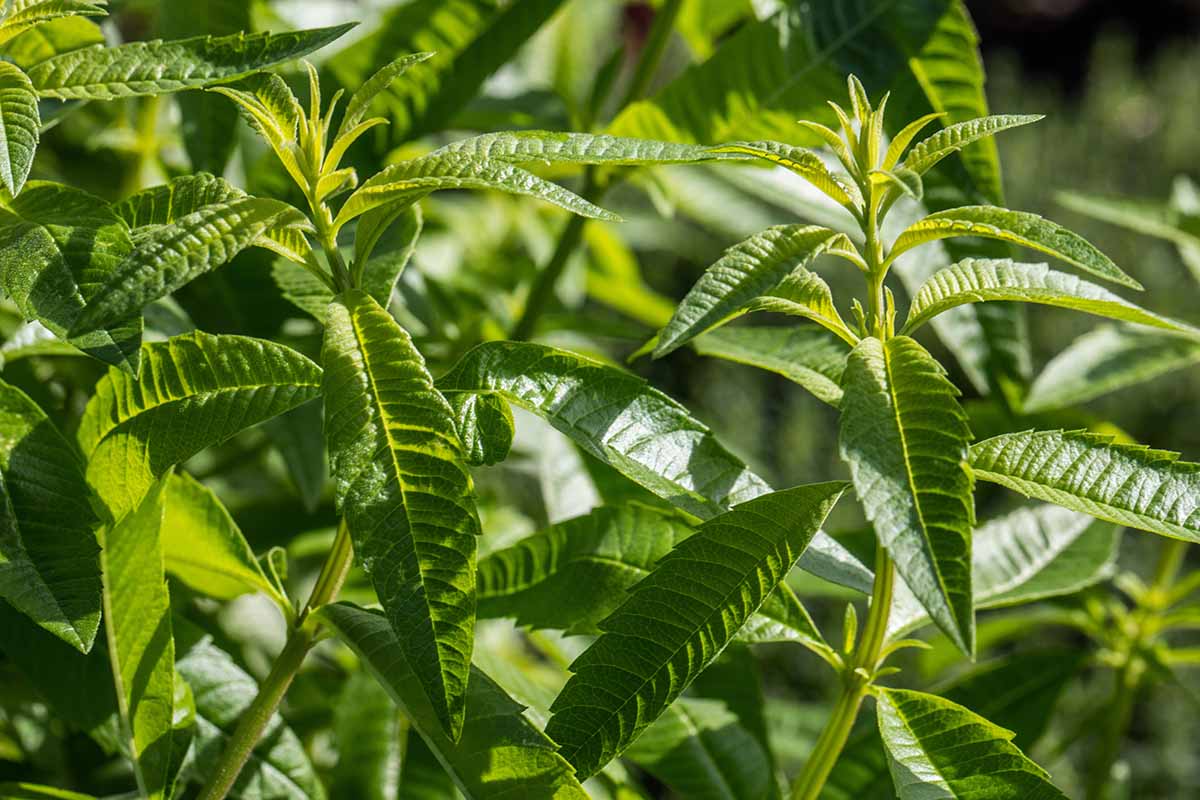

I stick the leaves into white fish and then wrap everything in banana leaves and steam it, and now it’s a recipe I can’t imagine not having during the summer.
A friend dries the leaves and presses them into soap that she sells at the farmer’s market, and they’re a hit.
How will you use up your bounty? Trust me, once your plant reaches a few feet tall, you’ll be looking for lots of new ways to enjoy the harvest, so let us know your plan in the comments!
I genuinely hope this guide pointed you in the right direction and that you’re growing a fantastically happy A. citrodora right now.
If you’re looking to add some lesser-known herbs to your garden, we have a few other guides that might be of interest, including:

